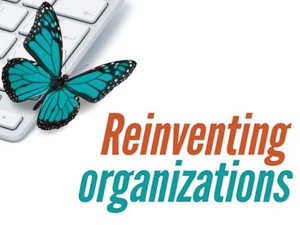Reinventing Organizations – Towards Evolutionary – Teal

We are reaching the end of our series !
We have discussed several topics from Frederic Laloux’s book. Aspects and attributes that all the researched companies in the book have in common.
But a question reminds as many of us might sense a calling for embracing « Evolutionary-Teal » principles, for “going teal” in their own organizations and companies.
What can we do ? Where do we start?
At first, it might seems discouraging if you read the author’s own words !
I believe that vertical transformation (from Amber, Orange, or Green, to Teal) is a lost battle”
Frederic then insists on the importance for top leaders, company owners and board members to have integrated a worldview and psychological development consistent with the Teal developmental level. He tells the story of 2 companies in his book who, once under market and financial pressure, went back to more well-known types of organization.
Board members that “don’t get it,” experience shows, can temporarily give a Teal leader free rein when their methods deliver outstanding results. But when the organization hits a rough patch or faces a critical choice, owners will want to get things under control in the only way that makes sense to them—through top-down, hierarchical command and control mechanism”
Yet, there are still a few things that can be done. Even if it is « just » to foster a healthier form of Orange. A big deal already, isn’t it ?!
Orange Organizations can be vibrant and innovative places where management by objectives gives people room to maneuver and to express themselves; or they can be stressful, lifeless places constrained by a thicket of rules, procedures, budgets, and targets. As a middle or senior manager, you can foster an environment that is as healthy as possible for your department within the Orange context”
Holacracy, which is one operating system for companies who want to go « Evolutionary – Teal », talks about 2 concepts which I really like:
– “Sense and respond” vs “Predict and control”
– “Processing tension” , tension being defined as « the felt-sense of a specific gap between current reality and a sensed potential”
Note: apart from the Holacracy website itself, I found this article on Holacracy very insightful.
Therefore, I think we can still as managers and team members foster an environment in which people are encouraged to sense issues and/or opportunities, and feel empowered to do something about it.
And also in which we feel empowered to address tensions. Providing more autonomy as well as role clarity and accountability will go a long way and is critical for people to feel they need and can address tensions as they see develop in their company.
In a self-managing organization, change can come from any person who senses that change is needed. This is how nature has worked for millions of years. Innovation doesn’t happen centrally, according to plan, but at the edges, all the time, when some organism senses a change in the environment and experiments to find an appropriate response. Some attempts fail to catch on; others rapidly spread to all corners of the ecosystem”
In addition, all researched companies have defined and published the core set of basic assumptions and principles under which they operate. For instance, FAVI’s three basic assumptions are : “people are systematically considered to be good (reliable, self-motivated, trustworthy, intelligent); there is no performance without happiness; value is created on the shop floor”.
So, what about exploring those assumptions with your own team?
This is what Frederic Laloux mentions:
Start by uncovering the unspoken assumptions behind the traditional hierarchical organizational (Amber/Orange) model: workers are lazy and untrustworthy; senior people have all the answers; employees can’t handle difficult news; and so forth. Many people find this exercise eye-opening. When they realize what a sad set of assumptions underlies traditional management models, they are eager and energized to define a more positive set of assumptions”
Your colleagues are more likely to embrace these practices if they understand the underlying motive. Why are you passionate about creating an organization where people relate more wholly with each other? Why is it important in your own life? You can also link the topic of wholeness to the organization’s purpose. Why does the organization’s purpose need us to show up whole?
I discovered in the book a nice “tool” used by some companies, called “Appreciative Inquiry” , which helps teams to explore questions like “How can we really be ourselves at work? .
 Teams are invited to explore in pairs and groups a series of questions (the below are just examples highlighted in the book):
Teams are invited to explore in pairs and groups a series of questions (the below are just examples highlighted in the book):
– Remember a time where you felt you could really be yourself at work, where you didn’t need to act or look the part in any way. Tell me about it. How did you feel at the time?
– At that time, did you sense a difference in your relationships with your colleagues (and possibly with your clients, your wife or husband, your children)? What was the atmosphere like?
– Did being fully yourself change anything about your work? Did you feel more productive, more innovative, more …? Tell me about it.
– Can you think back and try to remember what conditions were in place that helped you to be fully yourself at work?
Therefore, I think there are still ways you can start to embrace to develop more empowerment, engagement, purpose and trust so that colleagues bring more of themselves at work. And that is the leap we can decide to make.
Additional resources I found valuable:
– Comic book on Holacracy by Bernard Marie CHIQUET
– Holacracy journey at Zappos
– Buffer sharing very openly their journey as well as specific implementation of key processes (performance management, salaries and bonuses, …)
– A small company sharing its experience
Voila ! We have reached the end of that (long !) series of 8 posts ! My humble intention was really to share the aspects of the book which resonated the most with me, based on my own aspirations a well as experience as a manager and employee.
Reinventing Organization is an inspiring book. How we turn inspiration into concrete (small or big) change in our teams is what will ultimately make a positive impact, both in terms of business results as well as bringing our whole at work.

Leave a Reply